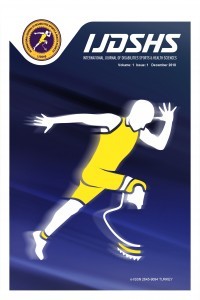Comprehensive Functional and Vocational Rehabilitation of A Kitchen Worker with Kienbocks Disease
Comprehensive Functional and Vocational Rehabilitation of A Kitchen Worker with Kienbocks Disease
Osteonecrosis, Pain, Physiotherapy, Hand Function,
___
- Bain, G. I., & Begg, M. (2006). Arthroscopic assessment and classification of Kienbock's disease. Techniques in hand & upper extremity surgery, 10(1), 8-13.
- Cetti, R., Christensen, S. E., & Reuther, K. (1982). Fracture of the lunate bone. Hand, (1), 80-84.
- Edouard, P., Vernay, D., Martin, S., Hirsch, P., Bardoux, S., Grange, C., & Claise, J. M. (2010). Proximal row carpectomy: Is early postoperative mobilisation the right rehabilitation protocol?. Orthopaedics & Traumatology: Surgery & Research, 96(5), 513-520.
- Gelberman, R. H., Bauman, T. D., Menon, J., & Akeson, W. H. (1980). The vascularity of the lunate bone and Kienböck's disease. The Journal of hand surgery, 5(3), 272-278.
- Green DP. Proximal row carpectomy. Hand Clin. 1987 Feb 1;3(1):163-8.
- Innes, L., & Strauch, R. J. (2010). Systematic review of the treatment of Kienböck's disease in its early and late stages. The Journal of hand surgery, 35(5), 713-717.
- Richou, J., Chuinard, C., Moineau, G., Hanouz, N., Hu, W., & Le Nen, D. (2010). Proximal row carpectomy: long-term results. Chirurgie de la Main, 29(1), 10-15.
- Shah, P.S., Shinde, S.B. (2018). Effect ofdesensitization methods during the earlymobilization phase in post-fractureconditions of upper extremity. Asian journal of pharmaceutical and clinical research; 11(7), 93-96.
- Shinde, S. andGhadage, P. (2022). Return to Job of AConstruction Worker by ComprehensiveFunctional and Vocational Rehabilitation. Int JDisabil Sports Health Sci;5(2):97-104
- van Leeuwen, W. F., Janssen, S. J., Ter Meulen, D. P., & Ring, D. (2016). What is the radiographic prevalence of incidental Kienböck disease?. Clinical Orthopaedics and Related Research®, 474(3), 808-813.
- Skirven, T. M., Osterman, A. L., Fedorczyk, J., & Amadio, P. C. (2011). Rehabilitation of the hand and upper extremity, 2-volume set E-book: expert consult. Elsevier Health Sciences.
- Yayın Aralığı: Yılda 3 Sayı
- Başlangıç: 2018
- Yayıncı: Nevzat DEMİRCİ
Ufuk DOĞANCALI, Elif Tuğçe ÇİL, Feryal SUBAŞI
Knowledge of Workplace Postural Requirements Among Private Dental Practitioners
Lohan MORADİA, Aayushi BAGGA, Anusuya CHOWDHRY, Anusha GALLA, Kalyana CHAKRAVARTHY, Abhinav TADİKONDA
The Physical and Mental Health Benefits of Lifestyle Sports for Disabled People: A Scoping Review
Lewis YOUNGSON, Charlie FOSTER, Jeffrey LAMBERT
Comparison of Sports Injury Anxiety in Athletes Doing Sports on Different Surfaces
Hasan GERÇEK, İlayda Dilan IŞIK, Melike Naz GÜREL, Nihan ÖZÜNLÜ PEKYAVAŞ, Atahan ALTINTAŞ
Comprehensive Functional and Vocational Rehabilitation of A Kitchen Worker with Kienbocks Disease
Sandeep SHİNDE, Rutuja ARULEKAR, Saylee DHANE, Radha BHENDE, Apurva SAPTALE
Abdulkadir ERTÜRK, Büşra Nur ORHAN, Sümeyye Özge MALKOÇ, Ebru TEKİN, Fatma ÜNVER
